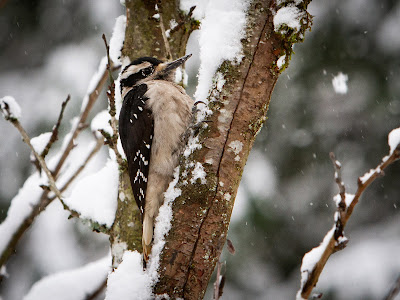For the Birds: Your Bird Muse for 2022
Thursday, December 30, 2021
 |
| This Song Sparrow has fluffed its feathers to trap warm air around itself. Photo by Craig Kerns |
By Christine Southwick
The first bird you see New Year’s Day is traditionally your guiding bird for that year. It is a fun way to connect with nature and to watch, learn, and embrace your local birds. What does “your” bird eat? Where does it nest — on the ground, in shrubs, planters, trees, or cavities in trees?
Every bird has some enduring qualities that allows them to thrive in this area, despite environmental challenges. Lessons and guidance can be gained from watching any specific bird.
Every bird has some enduring qualities that allows them to thrive in this area, despite environmental challenges. Lessons and guidance can be gained from watching any specific bird.
 |
| Bewick's Wren alert and looking for its next meal Photo by Craig Kerns |
European Starlings are smart, social and follow group dynamics. Closely-knit wheeling-flying displays called murmurations are an amazing sight to behold.
American Robins are the quintessential Early Bird belting out their cheery song. Since they eat worms and insects, they won’t come to your feeders, but will eat bugs from your yard.
“Little Brown Jobs” in our area includes Song Sparrows, Lincoln Sparrows, Savannah Sparrows, and even juvenile White-crowned and Golden-crowned Sparrows but each has a distinct song, niche, and trait, just waiting for you to discover it. These are all great bug and weed-seed eaters.
 |
| Black-capped Chickadee, cold and trying to stay warm Photo by Craig Kerns |
Band-tailed Pigeons, our native species, roost and nest near others — the basic group-lover. They require tall conifers.
Barred Owls, Great Horned Owls, Screech Owls are night creatures that see things often overlooked. They like to eat critters that roam at night. Keep those tall trees.
Bewick’s Wrens are inquisitive, talkative, eat your garden bugs, especially spiders, and fill your yard with liquid songs
Black-capped Chickadees often hang upside down, follow the rules, and have a strong mate-bond
Bushtits share well with others and communicate within groups
Cooper’s Hawks and Sharp-shinned Hawks survive by their wit and athletic prowess
Crows (American Crows) are highly intelligent and communicate with each other
 |
| Hairy Woodpecker Photo by Craig Kerns |
Spotted Towhees will come if your yard is healthy. These birds scratch through leaves and duff to find their arthropod meals. If your yard is blown clear of leaves and sterile, you won’t have these pretty natives.
Varied Thrushes - eye-candy plus inspiring songsters arrive in healthy yards in wintertime, when they come looking for shelter, seeds and arthropods.
Woodpeckers—Downy, Hairy, Pileated, Northern Flicker and Red-breasted Sapsucker all visit yards with trees — the bigger and taller the better. They rid your trees of bugs, and work hard to create a home site for themselves and other cavity dwellers
See previous For the Birds columns HERE




1 comments:
Such cute LBBs!!! (little brown birds)
Post a Comment